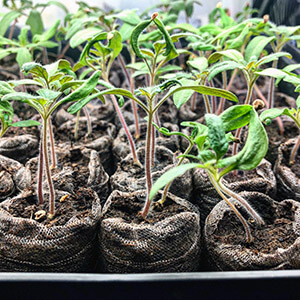
Give your vegetables a head start by seeding early indoors.
Although most people don’t start thinking about vegetable gardening until seedlings appear at local nurseries and box retailers, February is an ideal time to lay the groundwork for a productive spring and summer growing season.
By mid-February, it’s not too late to get your plants growing indoors. Doing this about eight weeks before the projected date of the last frost will reap great rewards when everyone else is just putting in their tomatoes, peppers and lettuces.
Consider starting seeds indoors with a grow-light set-up. Check with area nurseries and box retailers and talk with staff to find out what’s best for your goals. You can also visit online retailers, such as Park Seed, Gurney, Gardeners Supply, Burpee and Amazon, who offer turn-key set-ups that make seed starting easy.
Here’s what you’ll need: pots and trays, seed-starting mix, seeds and a light set-up. It’s a good idea to do some online research first to find out what’s out there. Pay attention to your grow lights. The key is strong lighting so that once the seeds sprout they will grow compactly. if they aren’t receiving enough light, the stems will stretch and become spindly.
Don’t be afraid to put the lights very close to the trays at first. You will need to experiment for just the right height, which will change over the course of germination.
Once the plants have their second set of true leaves, after the seeds leaves appear, they can be carefully transplanted into larger pots to prepare them for the garden. And they will need about 10 days of “hardening off” – putting them outside in shade to acclimate them to the outdoors – before you plant them in April.
The best advice and counsel
If you haven’t heard of joegardener.com, please Google him. Based in Milton, Joe Lamp’l; is a nationally syndicated gardening guru that’s broadcast on PBS stations across the country. Through his website, he offers podcasts, links to all his television episodes, connections with experts about everything from heirloom tomatoes to landscaping with food plants.
The website offers free guides, access to his blogs and videos that are instructional and comprehensive.
Joe also offers several virtual self-paced courses that once you pay for them, they’re accessible to you forever. Last year I purchased “Master Seed Starting:” and in January I began my review to prepare for my 2022 gardening.
“Beginning Gardener Fundamentals,” “Growing Epic Tomatoes,” “The Perfect Soil Recipe Master Class” and “Master Pests, Diseases and Weeds” deal with foundational issues when it comes to growing what you eat. it’s well worth the investment in online learning if you want to improve your gardening techniques and productivity.
For information, to access blogs and other educational tools, visit joegardener.com.
Photo: courtesy JoeGardener.com






